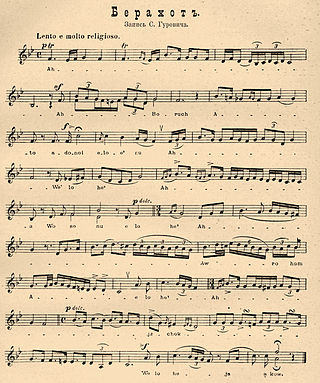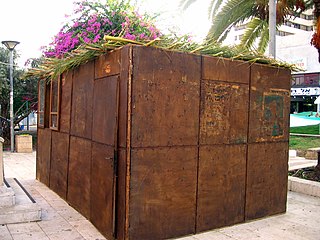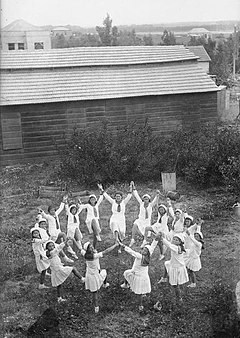
Jewish holidays, also known as Jewish festivals or Yamim Tovim, are holidays observed by Jews throughout the Hebrew calendar. They include religious, cultural and national elements, derived from three sources: mitzvot, rabbinic mandates, the history of Judaism, and the State of Israel.

Yom Kippur is the holiest day of the year in Judaism. It occurs annually on the 10th of Tishrei, corresponding to a date in late September or early October.

The Amidah, also called the Shemoneh Esreh, is the central prayer of the Jewish liturgy. Observant Jews recite the Amidah at each of three daily prayer services in a typical weekday: morning (Shacharit), afternoon (Mincha), and evening (Ma'ariv). On Shabbat, Rosh Chodesh, and Jewish festivals, a fourth Amidah (Mussaf) is recited after the morning Torah reading, and once per year, a fifth Amidah (Ne'ilah) is recited, around sunset, on Yom Kippur. Due to the importance of the Amidah, in rabbinic literature, it is simply called "hatefila". According to legend, the prayer was composed by the rabbis of the Anshei Knesset HaGedolah. Accordingly, in Judaism, to recite the Amidah is a mitzvah de-rabbanan, i. e., a commandment of rabbinic origin.

Av is the eleventh month of the civil year and the fifth month of the ecclesiastical year on the Hebrew calendar. It is a month of 30 days, and usually occurs in July–August on the Gregorian calendar.

Tisha B'Av is an annual fast day in Judaism. A commemoration of a number of disasters in Jewish history, primarily the destruction of both Solomon's Temple by the Neo-Babylonian Empire and the Second Temple by the Roman Empire in Jerusalem.
Tenth of Tevet, the tenth day of the Hebrew month of Tevet, is a fast day in Judaism. It is one of the minor fasts observed from before dawn to nightfall. The fasting is in mourning of the siege of Jerusalem by Nebuchadnezzar II of Babylonia—an event that began on that date and ultimately culminated in the destruction of Solomon's Temple, downfall of the Kingdom of Judah, and the Babylonian exile of the Jewish people.

The Seventeenth of Tammuz ) is a Jewish fast day commemorating the breach of the walls of Jerusalem before the destruction of the Second Temple. It falls on the 17th day of the fourth Hebrew month of Tammuz and marks the beginning of The Three Weeks, a mourning period leading up to Tisha B'Av.
The Nine Days of Av are a time of commemoration and spiritual observance in Judaism during the first nine days of the Jewish month of Av. The Nine Days begin on Rosh Chodesh Av and culminates on the public fast day of Tisha B'Av.
The Three Weeks or Bein ha-Metzarim is a period of mourning commemorating the destruction of the first and second Jewish Temples. The Three Weeks start on the seventeenth day of the Jewish month of Tammuz—the fast of the Seventeenth of Tammuz—and end on the ninth day of the Jewish month of Av—the fast of Tisha B'Av, which occurs exactly three weeks later. Both of these fasts commemorate events surrounding the destruction of the Jewish Temples and the subsequent exile of the Jews from the land of Israel. According to conventional chronology, the siege of Jerusalem by Nebuchadnezzar II occurred in 586/7 BCE, and the second siege of Jerusalem (70) by the Romans, in 70 CE. Jewish chronology, however, traditionally places the first destruction at about 421 BCE: see Missing years for more information.
This is an almanac-like listing of major Jewish holidays from 2000 to 2050. All Jewish holidays begin at sunset on the evening before the date shown. Note also that the date given for Simchat Torah is for outside of Israel. On holidays marked "*", Jews are not permitted to work. Because the Hebrew calendar no longer relies on observation but is now governed by precise mathematical rules, it is possible to provide, for the future, the Gregorian calendar date on which a holiday will fall.

A ta'anit or taynis is a fast in Judaism in which one abstains from all food and drink, including water.
A seudat mitzvah, in Judaism, is an obligatory festive meal, usually referring to the celebratory meal following the fulfillment of a mitzvah (commandment), such as a bar mitzvah, bat mitzvah, a wedding, a brit milah, or a siyum. Seudot fixed in the calendar are also considered seudot mitzvah, but many have their own, more commonly used names.

Sukkah is a tractate of the Mishnah and Talmud. Its laws are discussed as well in the Tosefta and both the Babylonian Talmud and Jerusalem Talmud. In most editions it is the sixth volume of twelve in the Order of Moed. Sukkah deals primarily with laws relating to the Jewish holiday of Sukkot. It has five chapters.
Kinnot are Hebrew dirges or elegies. The term is used to refer both to dirges in the Hebrew Bible, and also to later poems which are traditionally recited by Jews on Tisha B'Av.

A break-fast is a meal eaten after fasting.
The modern Hebrew calendar has been designed to ensure that certain holy days and festivals do not fall on certain days of the week. As a result, there are only four possible patterns of days on which festivals can fall.

Tu BiShvat is a Jewish holiday occurring on the 15th day of the Hebrew month of Shevat. It is also called Rosh HaShanah La'Ilanot, literally "New Year of the Trees". In contemporary Israel, the day is celebrated as an ecological awareness day, and trees are planted in celebration.
Yom tov sheni shel galuyot, also called in short yom tov sheni, means "the second festival day in the Diaspora". This is a principle in halakha that mandates the observance of an additional day for Jewish holidays outside the Land of Israel.
Sfeka d'yoma is a concept and legal principle in Jewish law which explains why some Jewish holidays are celebrated for one day in the Land of Israel but for two days outside the Land. The implications of sfeka d'yoma are discussed in Rosh Hashanah 21a and in the commentaries and poskim.









